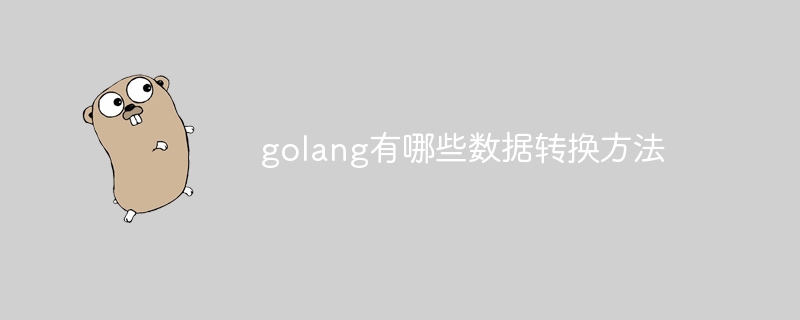
Golang data conversion method: 1. Type conversion operator; 2. Type assertion; 3. Conversion between strings and numbers; 4. JSON serialization and deserialization; 5. Use standard library Data conversion; 6. Use third-party libraries for data conversion; 7. Customize data conversion functions. Detailed introduction: 1. Type conversion operator. Go language provides type conversion operator, which is used to convert a value of one type into a value of another type; 2. Type assertion is another method of data conversion in Go language. , which allows an interface to be added at runtime and so on.

The operating system for this tutorial: Windows 10 system, DELL G3 computer.
In Go language, the main methods of data conversion are as follows:
1. Type conversion operator:Go language provides type conversion operator, which can be used Converts a value of one type to a value of another type. For example, to convert an integer to a floating point number, you can use the type conversion operator "float64()". It should be noted that when performing type conversion, you need to ensure that the target type can accommodate the source type, otherwise precision loss or overflow may occur.
2. Type assertion:Type assertion is another method of data conversion in Go language. It allows the value of an interface type to be asserted as a concrete type at runtime. Through type assertion, the value of an interface type can be converted into a specific type for subsequent operations.
3. Conversion between strings and numbers:Go language provides a variety of functions and packages for converting between strings and numbers. For example, you can use the function "Atoi()" in the "strconv" package to convert a string to an integer, and the "strconv.FormatFloat()" function to convert a floating point number to a string.
4. JSON serialization and deserialization:When processing JSON data, you can use the "encoding/json" package of Go language to serialize and deserialize JSON data. operate. Through JSON serialization, the data structure in Go language can be converted into a string in JSON format; through JSON deserialization, a string in JSON format can be converted into a data structure in Go language.
5. Use the standard library for data conversion:The standard library of the Go language provides many functions and tools for data conversion. For example, you can use the functions in the "math" package to convert between floating point numbers and integers, use the "encoding/base64" package to perform Base64 encoding and decoding, etc.
6. Use third-party libraries for data conversion:In addition to the standard library, the Go language also has many third-party libraries that can be used for data conversion. For example, you can use the "gconv" library for various types of conversions, and the "encoding/xml" library for XML encoding and decoding, etc.
7. Custom data conversion function:If the standard library and third-party library cannot meet specific data conversion requirements, you can write a custom data conversion function. Through custom functions, data can be converted and processed according to specific needs.
It should be noted that when performing data conversion, the correctness and safety of the conversion must be ensured. For some sensitive data or data involving security, additional processing and verification are required to avoid data leakage or security issues.
In short, the Go language provides a variety of data conversion methods and tools, and you can choose the appropriate method for data conversion according to specific needs. When using these methods and tools, attention needs to be paid to their correctness and security to ensure data integrity and reliability.
The above is the detailed content of What are the data conversion methods in golang?. For more information, please follow other related articles on the PHP Chinese website!




